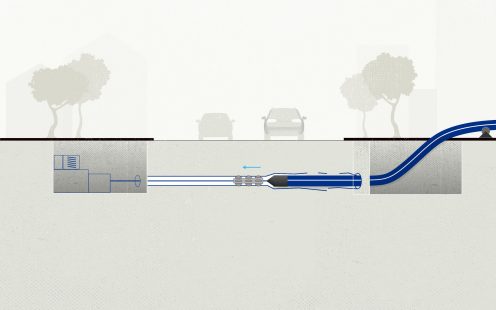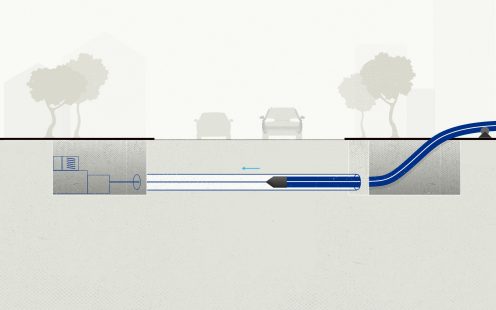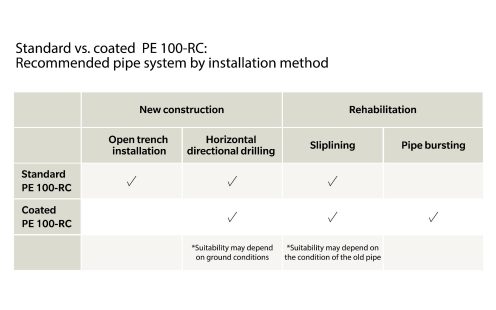Trenchless technology explained: No-dig methods for underground infrastructure expansion and replacement
With towns and cities expanding in size and population, existing pipe networks have to be upgraded to accommodate growing needs. This often requires replacing malfunctioning pipelines and/or expanding the network itself. In both cases, particularly in densely populated areas, available space is limited both above and below ground. This article explores three common no-dig technologies, using pressure pipe systems in gas, water and wastewater applications.
.jpg)
Introduction to trenchless construction
The trenchless industry has become a cornerstone of modern underground infrastructure development and maintenance. As cities expand and industries face increasing demands on their networks, trenchless technology offers solutions for both rehabilitating outdated pipelines and installing new ones.
Nowadays, trenchless construction is recognized for its versatility and effectiveness across a range of industries, including water and wastewater management, oil and gas transportation, and telecommunications.
Key advantages of trenchless technology
By utilizing advanced equipment and installation methods, such as pipe bursting, trenchless technologies facilitate the repair and replacement of damaged pipelines with minimal disruption to the environment, surface traffic and communal services.
Methods such as horizontal directional drilling are essential for navigating challenging environments, enabling the laying of pipelines under rivers, highways, and other obstacles that would otherwise complicate traditional construction.
Trenchless methods often provide a more cost-effective alternative to traditional open-cut excavation due to the lower costs associated with repairs of roads and landscapes.
Trenchless technologies typically result in minimal ground settlement, which helps protect surrounding underground infrastructure and reduce future maintenance needs.
Trenchless technologies for pipe rehabilitation and repair
Trenchless methods such as sliplining and pipe bursting allow for fast and cost-effective replacement of pipelines without extensive excavation. These techniques help preserve the structural integrity of nearby underground networks, such as water supply lines, sanitary sewers, and data and communication cables.
Both pipeline replacement methods deliver reliable, long-term solutions and are highly effective in preventing foreign water infiltration and inflow — issues that may result in significant costs and environmental risks.
Replacing old pipelines with pipe bursting
Wherever water mains or supply lines require replacement due to the end of their service life or insufficient capacity, it is often easiest to insert a pipe directly into the existing line using trenchless methods. One such method is pipe bursting or splitting. Instead of opening roads and removing large amounts of excavation material, only two shafts are required per section: an entry shaft for insertion and an exit shaft for drawing through the new pipe.
During the bursting process, the host pipe is destroyed while the new pipe is simultaneously drawn into its place. Pipe bursting is a highly specialized technique that should be performed by trained professionals only to ensure a safe, efficient and long-lasting replacement.
How does trenchless pipe bursting work?
Underground network sections that require replacement via bursting can extend several hundred meters in length. Depending on the available space on-site, specially designed PE 100-RC (resistant-to-crack) pipes with an additional protective coating can be pre-joined to the required length. Metal rods are inserted into the old host pipe and attached to a bursting or cutter head with an expander, which is in turn attached to the new pipe. A rod puller in the recipient shaft slowly draws the assembly through the host pipe, breaking it apart and displacing the debris into the surrounding soil.
Standard PE 100-RC pipes are exceptionally strong and resistant to mechanical forces. However, to prevent potential damage, coated pipes must be used for pipe bursting.
"The debris can put very high point loads on the installed pipe. Although scores and scratches may not seem critical at first glance, they can significantly reduce the replaced line's service life. Therefore, coated PE 100-RC products should always be used for this type of network rehabilitation," says Christian Bruckner, Infrastructure Product Manager at Pipelife Austria.

Sliplining: The oldest trenchless technology
One of the oldest and simplest trenchless repair methods is sliplining. As the name suggests, a new liner is slipped inside the existing pipe and guided through, following the host pipe's alignment. The liner takes the form of the host pipe’s interior, ensuring a snug and secure fit. Modern liners are often impregnated with thermosetting resins and may have materials such as fiberglass incorporated to enhance their structural strength and durability. The main limitation of this solution is the reduction in diameter, which decreases the pipe's overall capacity.
While standard PE 100-RC pipes are commonly used for sliplining, coated PE 100-RC liners offer several advantages. Their flexibility and nearly flush joints minimize the radial clearance between the host and inserted pipes. Furthermore, their smooth inner surface optimizes flow, partially offsetting the reduced capacity. These advanced liners also protect against corrosion, extending the service life of the rehabilitated line.
“Sliplining is a fast and extremely cost-efficient method. For example, a water supply line exceeding one kilometer in length in Paternion, Austria, was completely repaired within a few days, despite being segmented with bends and housing connections. Excavation and backfilling were required for only nine shafts, and the heavily frequented road above remained largely unobstructed,” Bruckner explains.

Trenchless construction: A low-impact solution for subsurface installations
One of the most significant advantages of the trenchless technology industry is its ability to deliver cost-effective solutions for underground infrastructure projects. By minimizing the need for excavation and surface restoration, trenchless methods can dramatically reduce construction costs and project timelines.
For businesses, utilities and municipalities, leveraging trenchless technologies allows achieving greater efficiency, lowering overall expenses, and minimizing environmental impact — all while ensuring excellent reliability of their underground networks.
Underpassing water bodies and obstacles with horizontal directional drilling (HDD)
Laying new water mains and communications service lines may require crossing roads, streams, or rivers. In such cases, trenchless horizontal directional drilling (HDD) enables the installation or replacement of pipelines at various depths, including below the water table, making the method highly effective in challenging subsurface conditions. HDD is also ideal in areas with dense underground utilities that are difficult, costly, or even impossible to bypass. Furthermore, the HDD technology offers a safe and reliable alternative for installing pressure pipes in areas where pipe bursting or splitting cannot be implemented due to soil or site restrictions.
How does horizontal directional drilling work?
Horizontal directional drilling is one of the most advanced trenchless technologies available today. The process begins by creating a pilot borehole that defines the pipe's alignment. Provided the location of all neighboring buried structures is known, technicians can steer the drill head from above ground, guiding it safely through soil and rock. Once the path is established, the borehole is gradually enlarged until the pipe can be drawn through.
"The final step in horizontal directional drilling is ideally completed in a single pull, before the drilling fluid supporting the boring process hardens. Depending on the required length, PE 100-RC pipes can be butt-welded in advance to the desired size. Pipelines spanning several hundred meters are very common with HDD," comments Bruckner.

What is the best pipe for trenchless technologies?
The advantages of trenchless solutions are obvious. However, they demand expertise, specialized equipment and exceptionally durable pipes that can withstand harsh conditions.
Recognizing the growing demand for trenchless construction and repair, Pipelife has developed coated PE 100-RC pipes designed to deliver a service life of at least 100 years even under the toughest installation scenarios. Manufactured with high-quality resins and advanced plastics, these pipes are engineered to withstand even the most demanding trenchless applications.
Importance of pressure pipe coating for trenchless technologies
Standard PE 100-RC pipes are already highly resistant to point loads and crack development. Under standard open-trench and trenchless conditions, the PE 100-RC products not only meet but exceed performance requirements.
However, in particularly demanding no-dig applications, pipes can be subjected to extreme mechanical stresses from contact with the host pipe, debris, sharp rocks and the tensile forces of pulling the pipe through. This is where an additional protective coating becomes beneficial.
Pipelife's specialized PE 100-RC pipes feature a durable coating that can be easily peeled off for efficient jointing. Extensively tested and certified to meet the most stringent national and international standards, these products offer unparalleled reliability in highly demanding environments.
"It is important to us that our clients know right away that they are working with state-of-the-art, top-quality products when they choose Pipelife," states Bruckner.

Industry-leading trenchless solutions for underground infrastructure
As the demand for sustainable and efficient infrastructure solutions continues to grow, the trenchless industry is set to play an increasingly vital role in shaping the future of underground infrastructure.
Trenchless technology has brought a low-impact alternative to conventional open-cut techniques, reducing damage risks to underground utilities, minimizing traffic interruptions and disturbances to other activities, as well as optimizing long-term costs — all while supporting more resilient infrastructure.
Find out more about
Get in Touch
Please choose your preferred way to get in contact with us. We will get back to you as soon as possible.
Fill our form